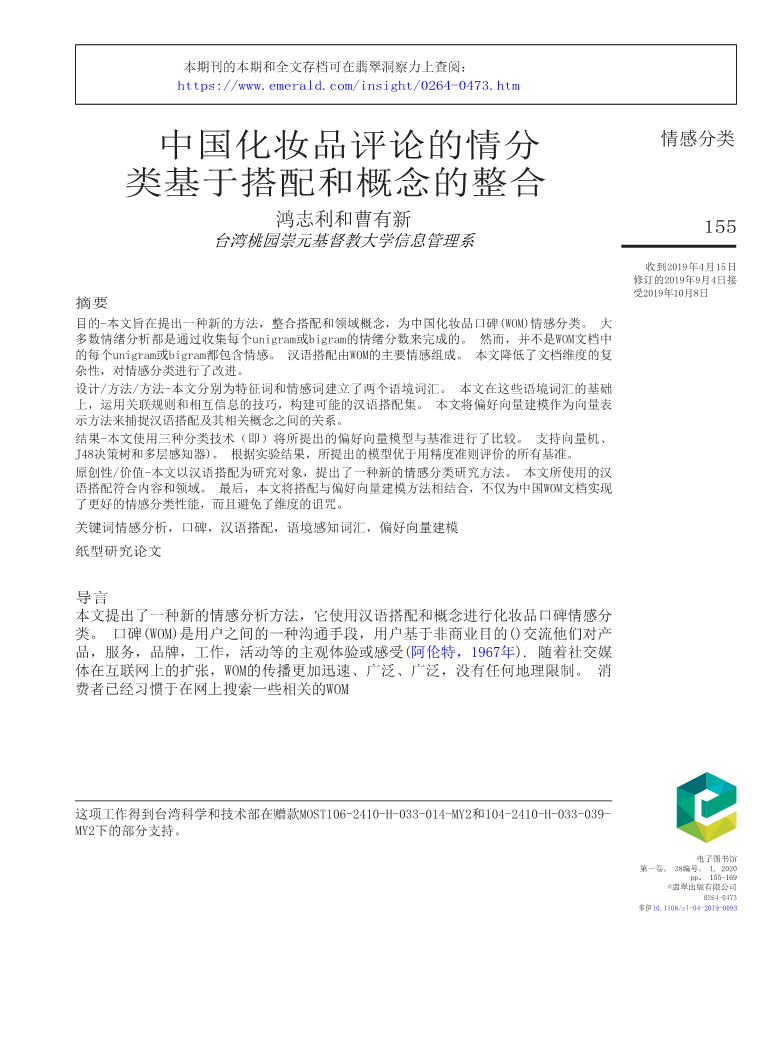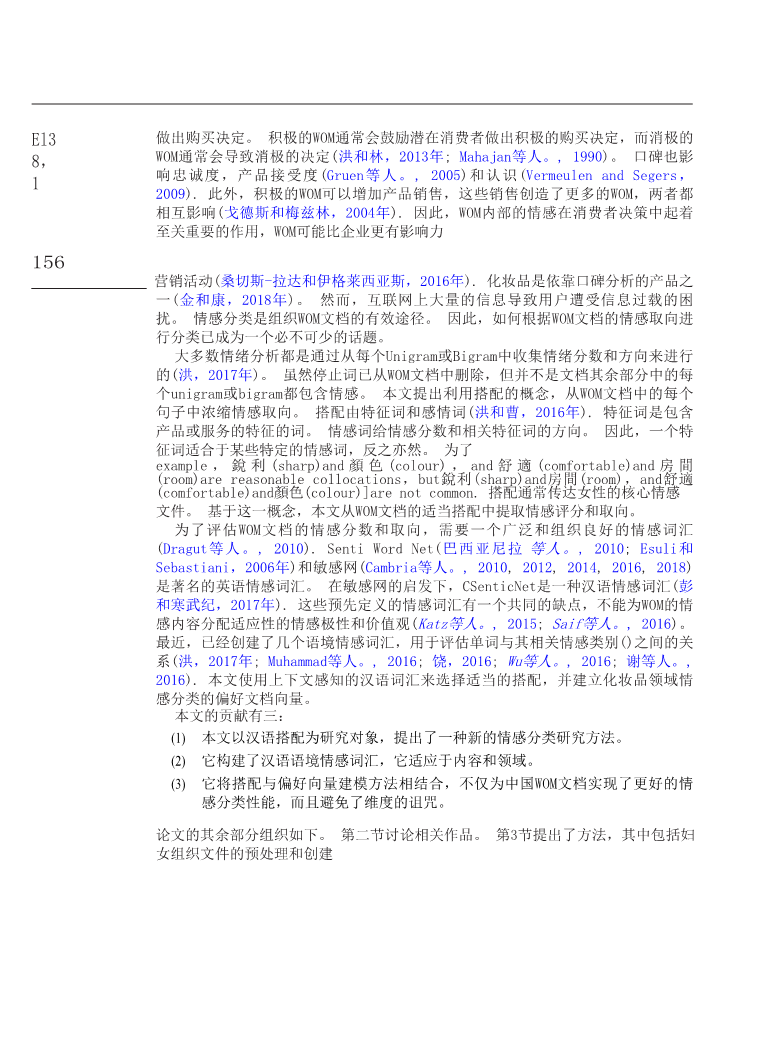The current issue and full text archive of this journal is available on Emerald Insight at:
https://www.emerald.com/insight/0264-0473.htm
Sentiment classification of Chinese cosmetic reviews
based on integration of collocations and concepts
Chihli Hung and You-Xin Cao
Department of Information Management, Chung Yuan Christian University, Taoyuan, Taiwan
Abstract
Purpose – This paper aims to propose a novel approach which integrates collocations and domain concepts for Chinese cosmetic word of mouth (WOM) sentiment classification. Most sentiment analysis works by collecting sentiment scores from each unigram or bigram. However, not every unigram or bigram in a WOM document contains sentiments. Chinese collocations consist of the main sentiments of WOM. This paper reduces the complexity of the document dimensionality and makes an improvement for sentiment classification.
Design/methodology/approach – This paper builds two contextual lexicons for feature words and sentiment words, respectively. Based on these contextual lexicons, this paper uses the techniques of associated rules and mutual information to build possible Chinese collocation sets. This paper applies preference vector modelling as the vector representation approach to catch the relationship between Chinese collocations and their associated concepts.
Findings – This paper compares the proposed preference vector models with benchmarks, using three classification techniques (i.e. support vector machine, J48 decision tree and multilayer perceptron). According to the experimental results, the proposed models outperform all benchmarks evaluated by the criterion of accuracy.
Originality/value – This paper focuses on Chinese collocations and proposes a novel research approach for sentiment classification. The Chinese collocations used in this paper are adaptable to the content and domains. Finally, this paper integrates collocations with the preference vector modelling approach, which not only achieves a better sentiment classification performance for Chinese WOM documents but also avoids the curse of dimensionality.
Keywords Sentiment analysis, Word of mouth, Chinese collocation, Context-aware lexicon, Preference vector modelling
Paper type Research paper
Introduction
This paper proposes a novel sentiment analysis approach which uses Chinese collocations and concepts for cosmetic word of mouth sentiment classification. Word of mouth (WOM) is a means of communication between users who exchange their subjective experiences or feelings about a product, a service, a brand, a job, an activity and so on based on a non- commercial purpose (Arndt, 1967). With the expansion of social media on the internet, WOM is diffused more rapidly, broadly, widely and without any geographic limitation. Consumers have become accustomed to searching online for some pieces of relevant WOM before
Sentiment classification
155
Received 15 April 2019 Revised 4 September 2019 Accepted 8 October 2019
This work was supported in part by the Ministry of Science and Technology of Taiwan under Grant MOST 106-2410-H-033-014-MY2 and 104-2410-H-033-039-MY2.
The Electronic Library
Vol. 38 No. 1, 2020
pp. 155-169
copy; Emerald Publishing Limited
0264-0473
EL 38,1
156
making a buying decision. A positive WOM usually encourages a potential consumer to make a positive buying decision, whereas a negative WOM usually results in a negative decision (Hung and Lin, 2013; Mahajan et al., 1990). WOM also affects loyalty, product acceptance (Gruen et al., 2005) and awareness (Vermeulen and Seegers, 2009). In addition, a positive WOM can increase product sales, and these sales create more WOM, both of which affect each other (Godes and Mayzlin, 2004). Thus, sentiments inside WOM play a crucial role in consumer decision making and WOM is possibly more influential than corporate
marketing activities (Saacute;nchez-Rada and Iglesias, 2016). Cosmetics is one of the products that rely on sentiment analysis of WOM (Kim and Kang, 2018). However, large volumes of information on the internet cause users to suffer from information overload. Sentiment classification is an effective way to organize WOM documents. How to classify WOM documents based on their sentiment orientations has, therefore, become an essential topic.
Most sentiment analysis works by collecting sentiment scores and orientations from each unigram or bigram (Hung, 2017). Although stop words have been removed from a WOM document, not every unigram or bigram in the rest of the document contains sentiments. This paper proposes using the concept of collocation to condense sentiment orientation from each sentence in a WOM document. A collocation consists of a feature word and a sentiment word (Hung and Cao, 2016). A feature word is a word containing a feature of a product or a service. A sentiment word gives sentiment scores and orientations to the associated feature word. Thus, a feature word is suitable for some specific sentiment words and vice versa. For
example, 銳 利 (sharp) and 顏 色 (colour), and 舒 適 (comfortable) and 房 間 (room) are reasonable collocations, but 銳利(sharp) and 房間(room), and 舒適(comfortable) and 顏色(colour)] are not common. A collocation generally conveys the core sentiments of a WOM
document. Based on this
剩余内容已隐藏,支付完成后下载完整资料


英语译文共 15 页,剩余内容已隐藏,支付完成后下载完整资料
资料编号:[605241],资料为PDF文档或Word文档,PDF文档可免费转换为Word


